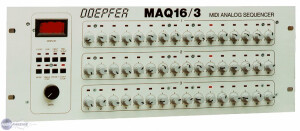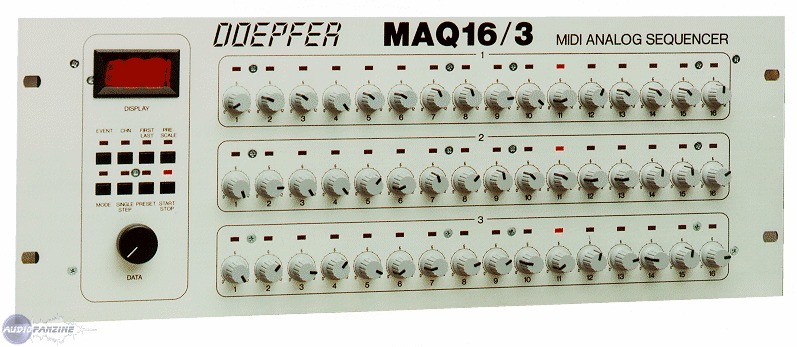Peut on avoir des sequence de 3*16 pas?
- 49 réponses
- 8 participants
- 3 970 vues
- 8 followers
Anonyme
leibniz

The P3 Sequencer is an 8 track, hardware MIDI sequencer, with a user interface comprised of knobs, keys and LEDs. A sixteen character by two line PLED display provides confirmation of pattern data and access to advanced features and configuration options.
P3 allows real-time control of track mutes and simple pattern or pattern chain selection across multiple tracks, plus analogue-style editing of patterns. Each of its 384 patterns has independent values for note, velocity, tie, gate, length, gate delay, and a combination of up to four MIDI controllers, extra notes, or 'auxiliary events', per step.
P3's unique auxiliary events allow the creation of dynamically self-modifying patterns. They can grab values from other tracks, randomise steps, alter track and global settings, and much more. There are three modulation 'accumulators' per track, that can be used as LFOs, perform arpeggiation effects or enable complex pattern progressions.
Furthermore, you can assign front panel knobs to modify or mask these events in real-time, allowing you to create interactive patterns that change predictably as you adjust the knobs - varying in complexity, controlling levels of randomness, even 'morphing' from one pattern to another.
A Force-to-scale option provides preset and user-defined scales to keep everything in key (but defeat-able per pattern step if required), and a configurable 'change mode' allows patterns with different lengths and/or time-bases to free-run, or be synced to a global bar.
P3 has a user configurable memory organisation that allows 3 banks of 16, 6 banks of 8, or 12 banks of 4 sixteen step patterns per track (a total of 384 patterns). Pattern length can be set from 1 to 16 steps, and multiple patterns can be chained in 'playlists' of up to 8 stages, with up to 8 repeats per stage.
RAM is battery backed, and can be dumped and loaded via sysex. Each track can output on a selectable MIDI channel, or multiple tracks can be assigned to the same channel.
There are three modes of operation - play, playlist edit and pattern edit. Mode changes are allowed while the sequencer is running. In fact, the only time you need to stop P3 is for a sysex dump or firmware upgrade.
In play mode, tracks can be muted and unmuted, and 'parts' can be selected individually or in chains. Parts are used to store pattern selections (playlists) for each track, and other settings such as global transpose and force-to-scale settings.
playlist edit mode is used to select the pattern, or sequence of patterns, that will play on each track - including options for individual pattern transpose and a 'global bar' system that can keep varying length patterns running in step.
pattern edit mode is where patterns can be created and modified using the 16 step keys, and 32 knobs.
The key function can be rotated between gate, tie (which can control a TB303 style auto-slide), skip and Xd (transpose defeat). The tri-colour LEDs show the current state at each step for the selected function.
Pattern length can be set using a soft function key, and various other features such as pattern rotate, copy & paste, randomisation, and data 'sculpting' are present.
The lower knobs are dedicated to note selection.
The upper knobs can be switched between velocity, gate length, step delay and the four auxiliary functions. The auxiliaries can be assigned per pattern to any combination of MIDI continuous controllers, or the auxiliary events.
There's also a real-time record feature, that allows you to quickly enter a pattern from a master keyboard, before making fine adjustments with the knobs. Or you can over-dub new note and velocity values from your keyboard, without affecting the existing pattern rhythm.
With auxes assigned to play extra notes, you can make your pattern up to 5 note polyphonic, and real-time record will record polyphonic patterns straight from a MIDI keyboard.
An arpeggio capture mode allows you to use P3 like an arpeggiator, with the ability to store arpeggios as normal patterns.
Internal resolution is 48 ppqn, which allows fine-tuning of step delay to create the same shuffle effects as the TR909, but with the ability to apply a different shuffle value to each step.
The unit has MIDI in, four MIDI out (single bus) and sync connections.
It can run as tempo master or sync to MIDI clock, and outputs DIN sync and clock-only MIDI from a dedicated SYNC output.
For a complete description of the functionality, please consult the user manual.
The P3 CPU supports firmware updates via MIDI SysEx, so frequent new features (and occasional bug fixes) are easily added - no nasty messing about with processor swaps, and posting chips back and forth !
Details of the sysex message format for firmware update can be found here.
An excellent Windows utility (written by a keen P3 owner) for sysex pattern management and firmware update is available from the Downloads area.
Alternatively, the .syx update files can be replayed using any sysex utility that supports raw sysex dump files. I highly recommend the excellent MIDIOx for this.
Pas mal également celui-ci ...
Mais bon, pour moi, ça sera un miodulaire.
“Pourquoi y a t il quelque chose et non pas plutôt rien?”
fisherPrice
Une ptite question:
Ou est l'interet de brancher ce genre de bestiole sur un microkorg??
Autant l'interet d'un synth analo est evident, autant celui d'un sequenceur analogique m'echappe completement.
Avec des machines qui marchent à coup de CV et autres barabaries analogiques, je comprends qu'une RM1X soit pas top sexy.
Mais sur un synth juste midi, et numerique????
(navré, je ne suis pas tres claire là...).
leibniz
“Pourquoi y a t il quelque chose et non pas plutôt rien?”
fisherPrice
autant se trouver une rmx d'occaz'...
'fin bon...
leibniz
En fait, je viens de regarder les specs, le RM1X n'est pas un séquenceur à pas... Je crois que la surface du MAQ est quand même plus ergonomique pour faire des séquences modulées qui tournent en boucle, non ?
“Pourquoi y a t il quelque chose et non pas plutôt rien?”
fisherPrice
Hors sujet : a la base c'est une groove box avec tout un tas de sons pas terribles...
tu as (de memoires) 16 pistes, avec un sequenceur plutot bien foutu, et tu n'est pas limite a 16 pas. Mais avec le midi out tu envois se que tu veux, notes CC, PC et tout le reste.
J'ai connu des gens que ne s'en servaient plus qu'en sequenceur.
leibniz
Hors sujet : perhaps... ce qui me gène dans le RM1x, c'est qu'on a pas les rangées de 16 potards pour sculpter la boucles en temps réel...
“Pourquoi y a t il quelque chose et non pas plutôt rien?”
fisherPrice
Hors sujet : ooooooook, bha voila, c'est ça!!! oui, vu comme ça c'est interessant comme approche.
Anonyme
leibniz
“Pourquoi y a t il quelque chose et non pas plutôt rien?”
- < Liste des sujets
- Charte




